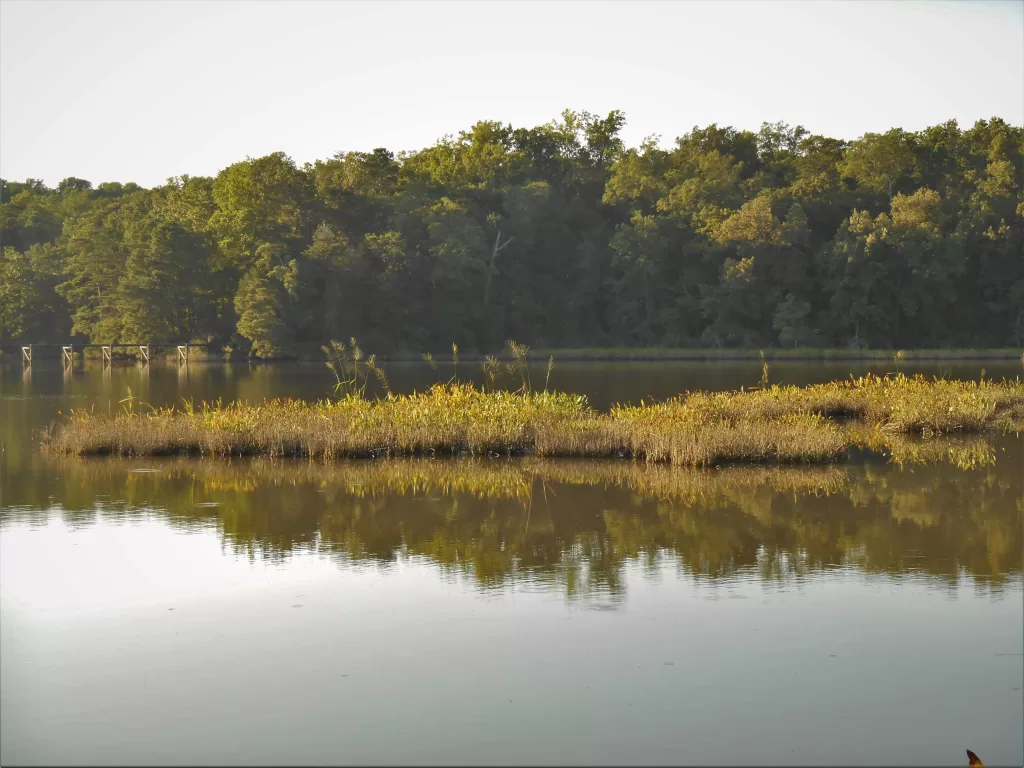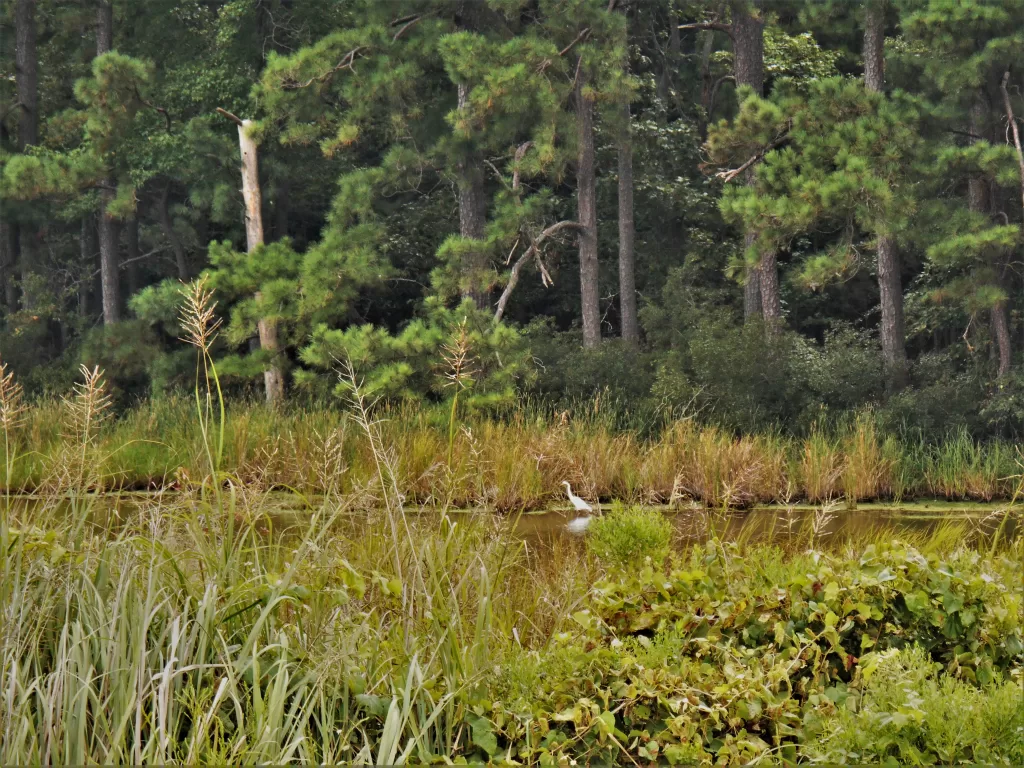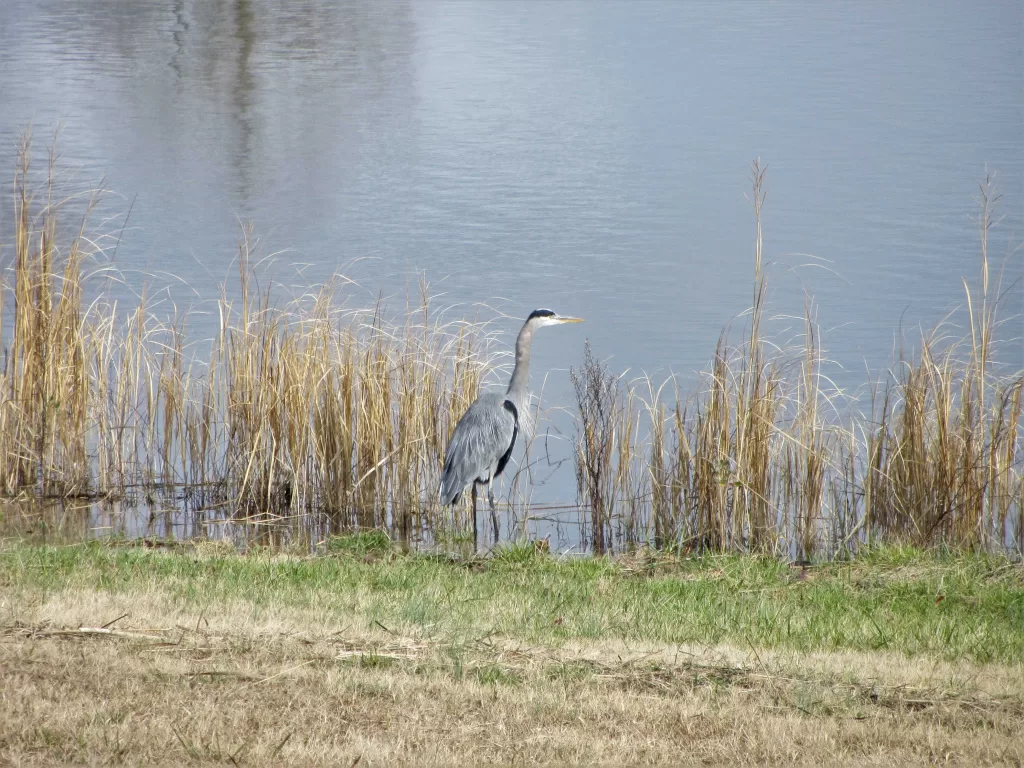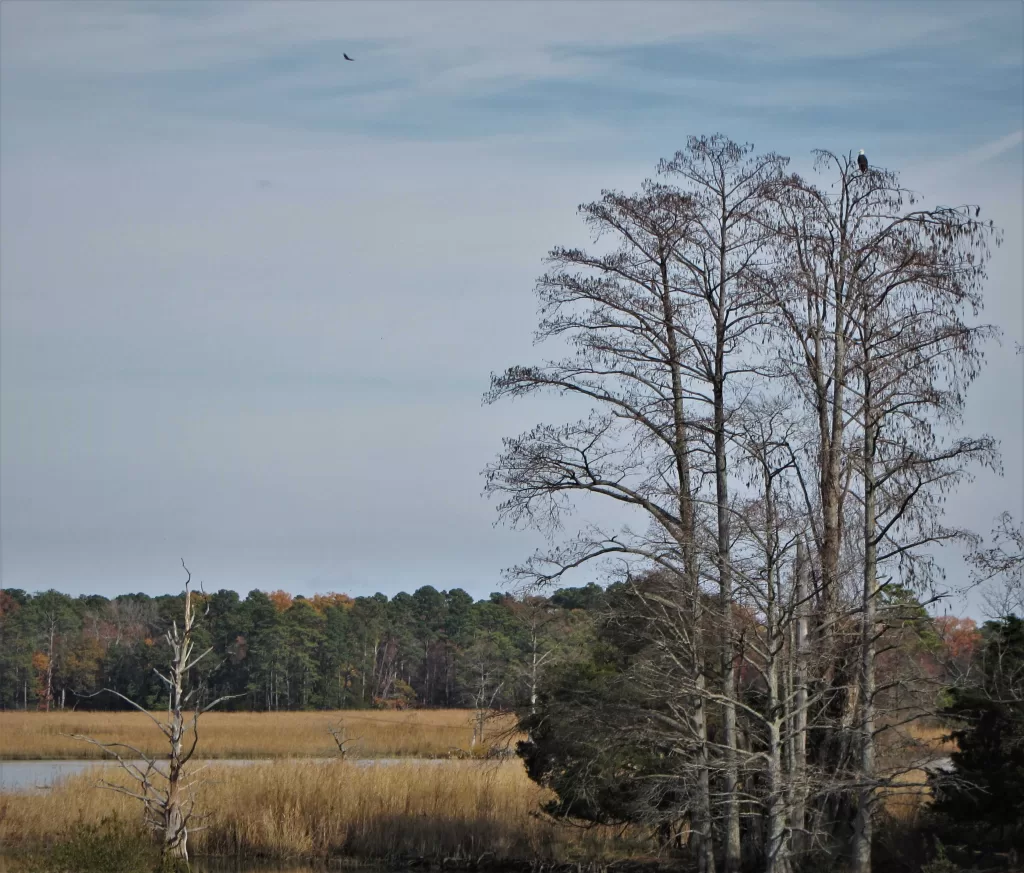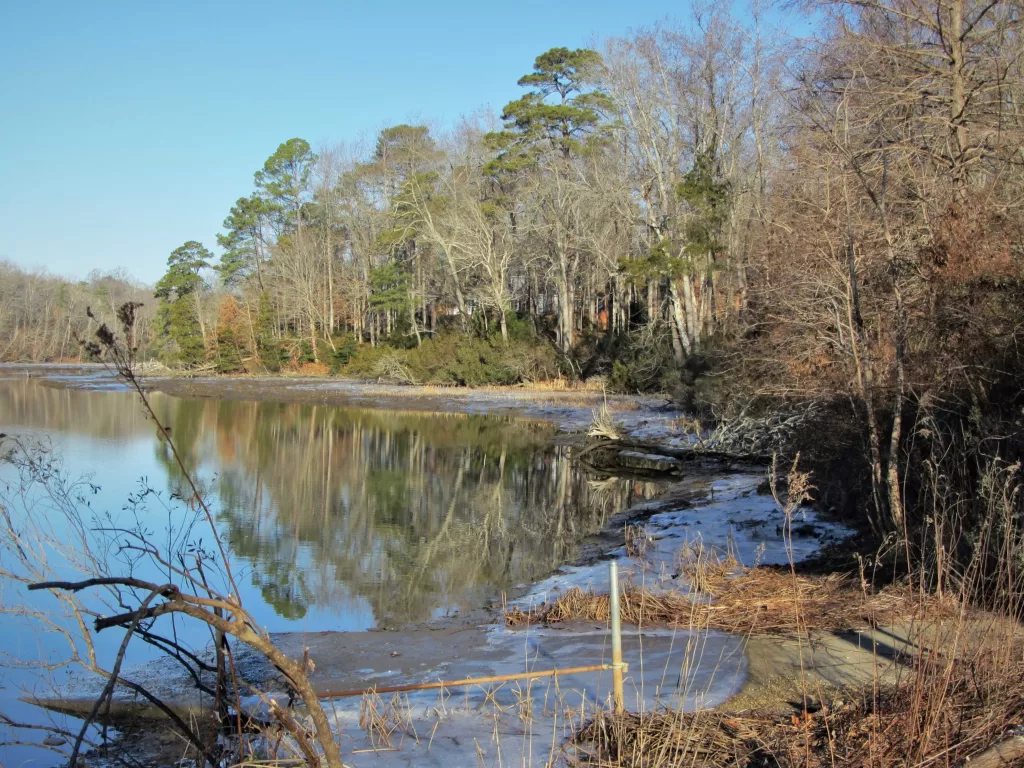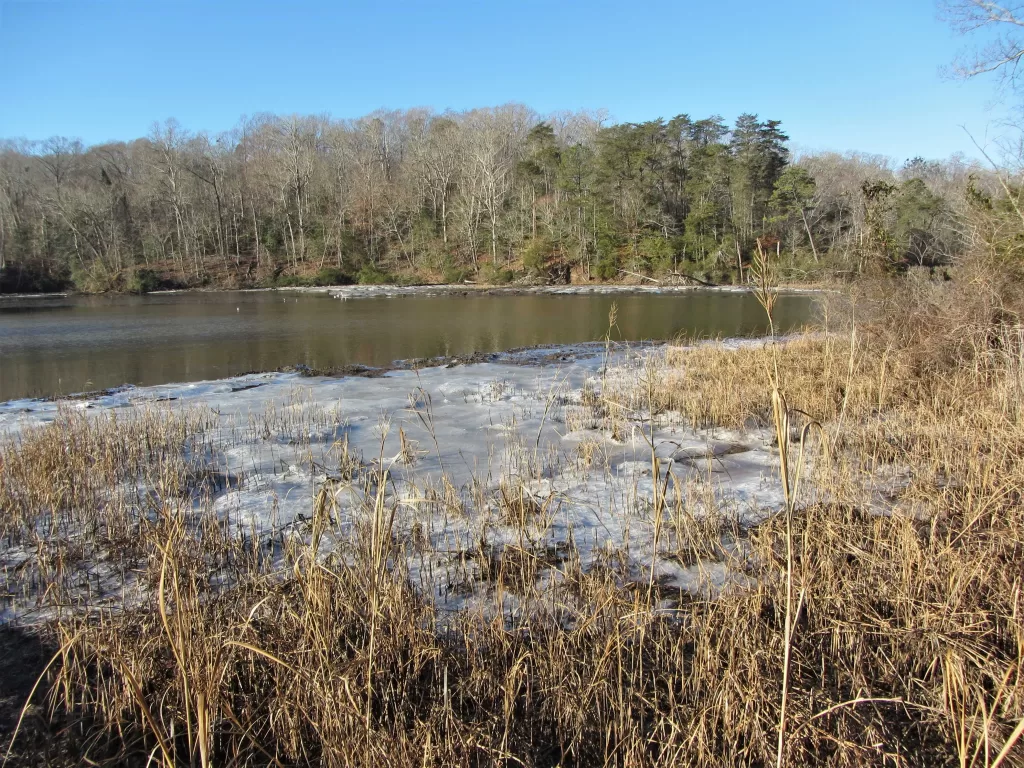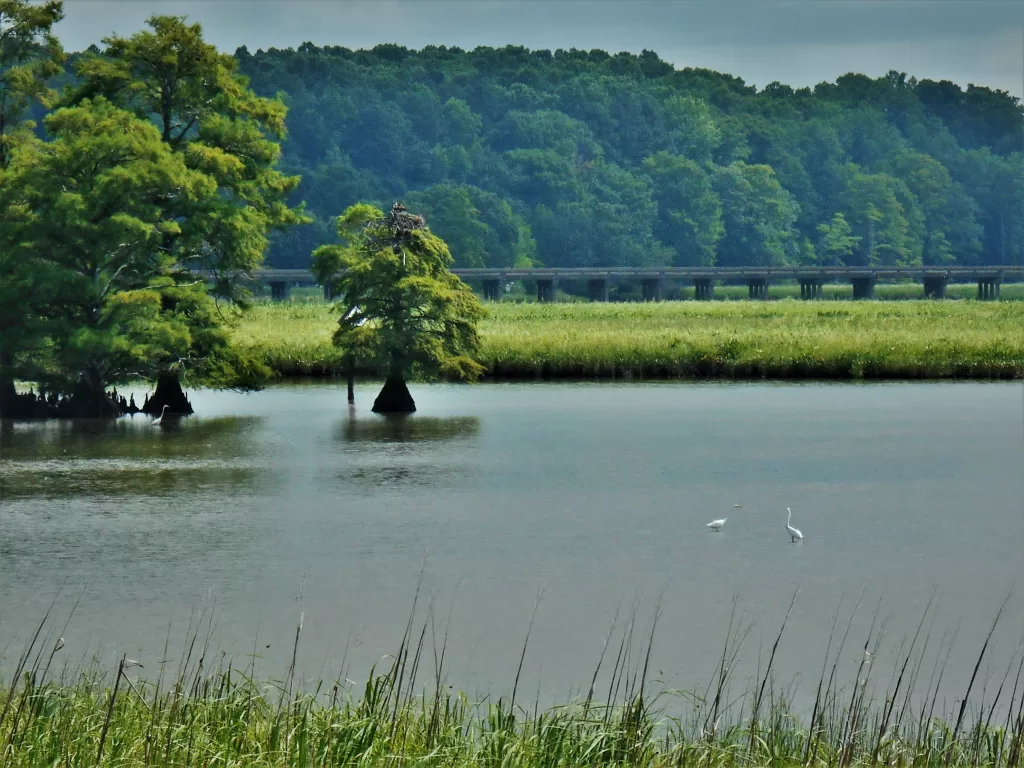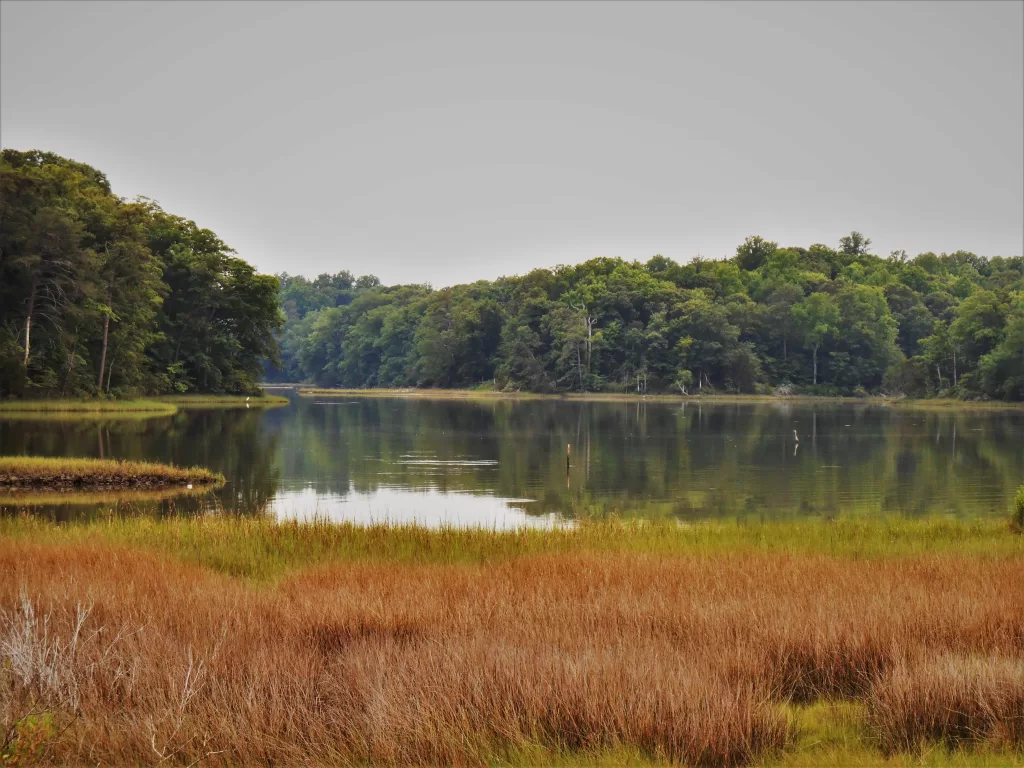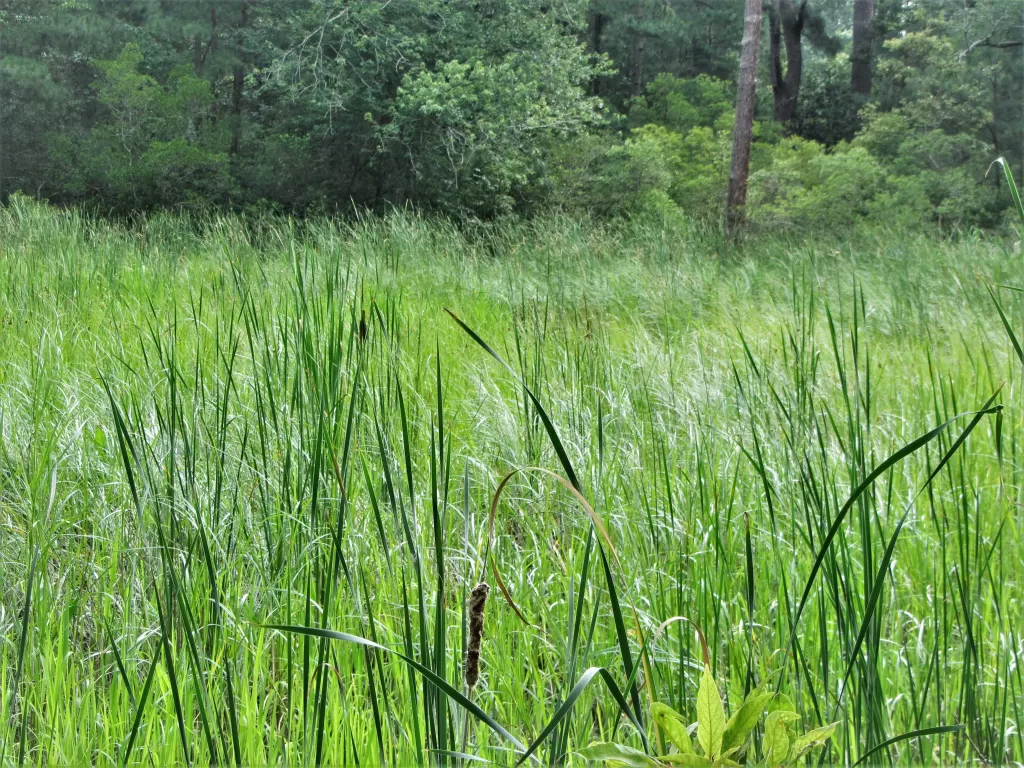Phragmites in Local Wetlands- Updated
“… despite its bad reputation, Phragmites provides many benefits that are generally unknown and unappreciated. After studying salt marsh ecology and the impacts of stressors, including invasive plants, for many years, I have concluded that removing this invasive species wherever it is found – especially along vulnerable coastlines – is a very expensive and often foolish procedure.”
Dr. Judith Weis, Professor Emerita in Biological Sciences Rutgers University
Historically, Phragmites Are Part an Important Part of the Ecosystem
Our local creeks, marshes, and ponds lie surrounded by thick stands of reeds, Phragmites australis. Phragmites are a very tall, tough, long-lived grass. Like other grasses, they grow from extensive mats of roots and rhizomes, creeping along in the mud. Native Phragmites australis subspecies americanus, grow across North America from southern Canada south to the Mexico border in the west. On the east coast, they grow as far south as our border with North Carolina.
Another species of Phragmites, possibly native to North America, grows along the Gulf coast. Phragmites australis subspecies berlandieri may have crept northward from Central and South America at some point. It has now moved westward and is found in parts of Arizona and California. Items made from reeds, found in archeological digs in the American Southwest, date to over 40,000 years old.
Native Phragmites co-exist with other marsh and aquatic plants. They were used by Native Americans for food, shelter, and to make useful things. Every part of the plant is edible. Spring shoots may be harvested and eaten like bamboo shoots.
A hardier species, P. australis, grows across much of Europe, North Africa, and the Middle East. They are an ancient species, used for many purposes over thousands of years. These ‘old world’ Phragmites traveled to North America on European ships in the 18th and 19th centuries, though DNA analysis by the National Park Service has determined that some strains of P. australis predate colonization. Transplanted to North American waters, they have become invasive, choking out the native Phragmites and other plant species which grow along our waterways. Emerging early in the spring, before the native species and before many other aquatic plants, they grow taller and with more vigor than the native Phragmites australis, subspecies americanus.
How Do Phragmites Function in the Ecosystem?
Phragmites filter both air and water during their long season of growth. They can be used to filter and sequester heavy metals and other pollutants from wastewater and contaminated sites, trapping harmful chemicals in their biomass. They are planted in some areas for this purpose.
Phragmites help catch run-off silt from erosion on land. They tolerate brackish, salty, or fresh water and they can hold areas in wetlands which might otherwise erode from run off, tides, and flooding. This makes them useful in holding shorelines during extreme weather events.
Phragmites filter and sequester carbon, a major greenhouse gas, using it for metabolism and growth. While filtering carbon, they also remove other polluting gasses from the air we breathe, releasing pure oxygen and water vapor. The carbon, converted to cellulose, remains trapped in the grass’s tissues both above and below the soil.
What Has Accelerated the Spread of Phragmites?
European P. australis grows stronger, taller and faster than the native plant species it is replacing, and that growth is accelerated by fertilizers used on lawns, pet waste, and agricultural waste that run off into local waterways. Phrags absorb excess nitrogen from this run off, and from the muddy bottom of the creek, and sequester it in their tissues. Phragmites are spreading most rapidly in nitrogen-rich local wetlands, creating a monoculture so that fewer plant and animal species inhabit sensitive wetlands. They take root in disturbed areas where other vegetation has been disrupted or removed along the shoreline.
In a 2008 William and Mary study of Phragmites in the Chesapeake Bay off Maryland, researchers found that 17% of the phragmites-dominated shoreline was adjacent to farmland even though agricultural land was only 11% of the total shoreline surveyed.
The Structure of Phragmites
Thick, dense vertical stems grow anew each spring to 13’-20’ tall, shading other plants in their midst. Phragmites stems are hollow, like bamboo. Large leaves grow at nodes along the length of the stem, much like the leaves on a stalk of corn. The plant is crowned with a large plume of flowers, which produce thousands of seeds each season.
Phragmites quickly develop an extensive system of deep roots and below-ground rhizomes which may grow up to 3’ deep and up to 10’ away from the clump to colonize new territory, annually. New plants emerge from nodes along the rhizomes. Any small piece of a broken rhizome can grow into a new plant.
This deep, extensive root system makes the plant extremely hard to eradicate because cutting or burning the plant won’t destroy it. Phragmites colonies must be burned or treated with herbicides for several years in succession to eventually kill their deep roots. Removing the previous season’s growth the winter after herbicidal treatment is an important component of successful Phragmites extermination efforts.
Phragmites Change the Waterways Where They Grow
Stolons, or horizontal stems on the soil surface, also grow many feet each year. New plants emerge at each joint in the stolon, and each of these new plants sends down new roots. The result is a very dense, thick mat of growth at and below the surface. This root system catches sediment in waterways, so the water grows progressively shallower each year as Phragmites colonies grow.
It is easy to see why these Phragmites spread so quickly! They not only spread through growth of their rhizomes and stolons each year, but their seeds travel by air and water to colonize new areas. Only a few animal species eat the seeds. We aren’t currently harvesting and using these reeds in any substantial way. Phragmites are colonizing North American wetlands at an astounding rate.
Phragmites die back each winter and re-emerge each spring. They eventually form a wall between the shoreline and the water, blocking the view and creating a dense barrier for anyone trying to access the water for fishing or boating. Sea level rise enables Phragmites colonies to spread onto once dry land, crowding out trees and turning both fields and forest into marshland.
Efforts to Eradicate Phragmites
Many communities, environmental advocacy groups, and government agencies across the United States have launched extensive efforts to eradicate Phragmites in recent decades, including groups within James City County. All eradication efforts are expensive and must be repeated during successive years to achieve success. Because Phragmites are already widespread, new colonies continue to emerge in new areas from seed or bits of rhizome.
The recommended methods to remove Phragmites include burning, mowing followed by digging out the roots and rhizomes, flooding with at least 3’ of water, and spraying with herbicides approved by the EPA for use in wetlands. When the Phragmites have colonized large areas, the herbicides are sprayed from a helicopter.
According to Justin Doyle, Director of Community Conservation for The James River Association, the JRA’s Phragmites management project concluded in 2022. He and his colleagues advise that it is difficult to eradicate Phragmites from a large body of water, like College Creek.
Local Efforts to Eradicate Phragmites from College Creek
Some College Creek neighbors, particularly those with waterfront property, have supported efforts to spray herbicides on Phragmites colonies in College Creek in past years. Their contractors have used back-pack spraying gear to spray phrags with herbicides, from boats. Even with this management effort, Phragmites colonies continue to expand in College Creek.
This year The Conservancy’s HOA is organizing an effort to spray the herbicide Imazapyr, a systemic, non-specific herbicide which disrupts a plant’s DNA, over larger areas of College Creek from a helicopter in October. A representative of The Conservancy’s HOA contacted representatives of other nearby neighborhoods and nearby landowners in early September to ask for contributions to fund this project. They estimate it will cost around $20,000 to mount this spraying operation.
Imazapyr is approved for use in wetlands in Virginia. As a non-specific herbicide, it will slowly kill any plants it reaches during the aerial spraying, including native trees and marsh plants. Clouds of herbicide sprayed from a helicopter, then drifting with any wind, will likely reach and kill nearby trees and marsh plants in addition to the targeted Phragmites colony.
When the herbicide kills native plants in and around the Creek, those spaces remain open for new colonies of Phragmites to take root if the area isn’t also replanted with desirable aquatic plants. Experience has shown that the only way to effectively prevent phrags from recolonizing herbicide treated wetland areas is by replanting native plants where the phrags were previously growing.
Laboratory testing by the EPA in 2005 indicated that Imazapyr has low-level effects on fish, birds, and small mammals. (Find several sources of more information about this herbicide below.) Testing wasn’t conducted on reptiles and amphibians. But those spraying are required to wear full PPE, including goggles, because of the irreversible damage it does to the eyes. There is no research which indicates that this herbicide won’t also damage the eyes of wetland animals and birds, especially eagles and herons, in the area during spraying.
The direction and amount of drift of the herbicide during spraying will be determined by the weather, including wind speed and direction, and the flight pattern the helicopter follows on the day of spraying. We have asked to have several days notice before the spraying so that any concerned neighbors in Kingspoint can keep their doors and windows closed that day.
The Efficacy of Herbicidal Treatments on Phragmites
According to Dr. Randy Chambers, a wetlands ecosystems expert at William and Mary:
“When the Phragmites stands get large enough that you need a helicopter to spray it, it is too late. Spraying programs must run for at least 3 years to be effective, and typically the individual treatments go awry—it rains after spraying, or the tide washes the chemical away, or the plants aren’t active and are unaffected, etc, etc.
Inevitably, the Phragmites will grow back unless someone follows up with on-the-ground work including hand spraying of Phragmites and planting of native vegetation. One can try to contain it and keep it from expanding to where it isn’t, but I doubt one can remove it from where it is, now that the stands are so large along College Creek. That said, there are small stands of Phragmites that are popping up in different locations along College Creek and Halfway Creek and Tutters Creek. Those small stands can be treated effectively by backpack spraying. Once the stand gets to ½ acre in size, there’s not much one can do except wait for sea level rise to drown it out…”
Update 10.24.23: “No Regulation or Oversight Needed”
The JCC Division of Stormwater and Resource Protection determined that it wasn’t necessary for private citizens to obtain any permits before using herbicides to kill around 10 acres of Phragmites and other marshland plants in the areas around the Williamsburg-Jamestown Airport, The Vineyards community, and The Conservancy community. All of the land this group, which includes the owner of the airport, plans to treat are within Resource Protection Areas. Some of the phrag stands on this western bank of College Creek were treated previously by operators using backpack sprayers on foot and from small boats. Some of the areas the group intends to treat are new areas only accessible by air.
Since the local Wetlands Board and county staff decided that no permit was necessary, there were no public hearings, and the VMRC and other agencies which normally help regulate what happens within the James River and Chesapeake Bay watershed, had no role in regulating this destruction of plants growing in the waterway.
A New Plan to Kill Functional Plants in College Creek
The new plan, as described in a phone call on October 11 by Mr. Douglas McGhee, who is heading up this initiative for The Conservancy’s HOA and for the airport, is to use a small drone to spray Imazapyr over the Phragmites stands from an altitude lower than a helicopter could achieve. The specialized drone has emitter nozzles to target the spray on the phrags with more accuracy than a helicopter could achieve. Mr. McGhee acknowledged that even this modified plan would allow for airborne herbicides to drift to other areas of the Creek, and the herbicides will be in the water, moving with the tide each day, until the chemicals either settle in the silt (where they can’t break down) or the chemicals in solution in the waterway break down in the sunlight after about a week.
The Phragmites growing in areas adjacent to the airport perform an important ecological function to absorb carbon dioxide and other pollutants in the exhaust from the aircraft using the airport daily. Since the small aircraft used by the aviation school based at this airport use unleaded aviation fuel, the planes’ exhaust is a major source of air pollution which contains vaporized lead. The phrags are able to absorb lead, and other heavy metals from the water, silt, and air.
Lead Pollution From Aircraft
On October 19, the Washington Post has published a new story: “Lead pollution from small planes threatens human health, EPA finds.”
This excerpt from the article might concern families who lives beneath the flight paths of the student planes coming and going from the Williamsburg-Jamestown airport:
“The Environmental Protection Agency on Wednesday announced it has determined that lead emitted from airplanes is a danger to public health, opening the door for the agency’s first limits on lead fuel in aviation. The move puts the Biden administration in the middle of a brewing fight over how long airports — particularly smaller ones — can continue selling leaded gasoline, despite the health hazards from this powerful neurotoxin. More than 170,000 smaller planes, known as piston-engine aircraft, still use leaded gasoline, according to the EPA, and there is an ongoing dispute about how quickly this form of fuel can be phased out at thousands of airports nationwide.”
Ironically, the very Phragmites that the airport’s owner and Conservancy residents want to spray herbicides over to eradicate from the wetlands bordering the airport and adjacent communities functionally remove carbon dioxide and other pollutants from the air and absorb heavy metal pollution from the silt of the creek. They plan to kill ten acres of the very plants that can mitigate the pollution from the aircraft coming and going from the airport each day. The Phragmites are growing where they are most needed to purify the pollutants in the creek.
For More Information about Phragmites:
For Better or Worse, Invasive Phragmites is Here to Stay from the Bay Journal. 2023
Rhizomes, Getting to the Root of It All from the Great Lakes Phragmites Collaborative. 2020
Phragmites Field Guide. 2010
Invasive Species of the Chesapeake Bay From the Chesapeake Bay Program. 2023
For More Information about Imazapyr:
EPA Memo of Risk Assessment for Imazapyr. 2010
Imazapyr Considerations from the Florida Center for Invasive and Aquatic Plants. 2023
Imazapyr Chemical Fact Sheet from the Wisconsin Department of Natural Resources. 2012
All photos by E. L. McCoy

